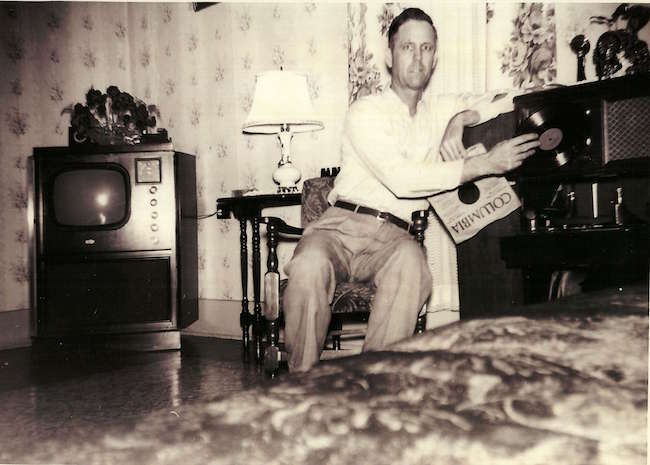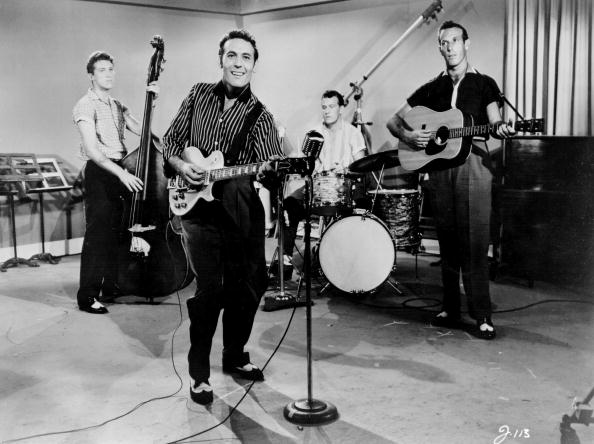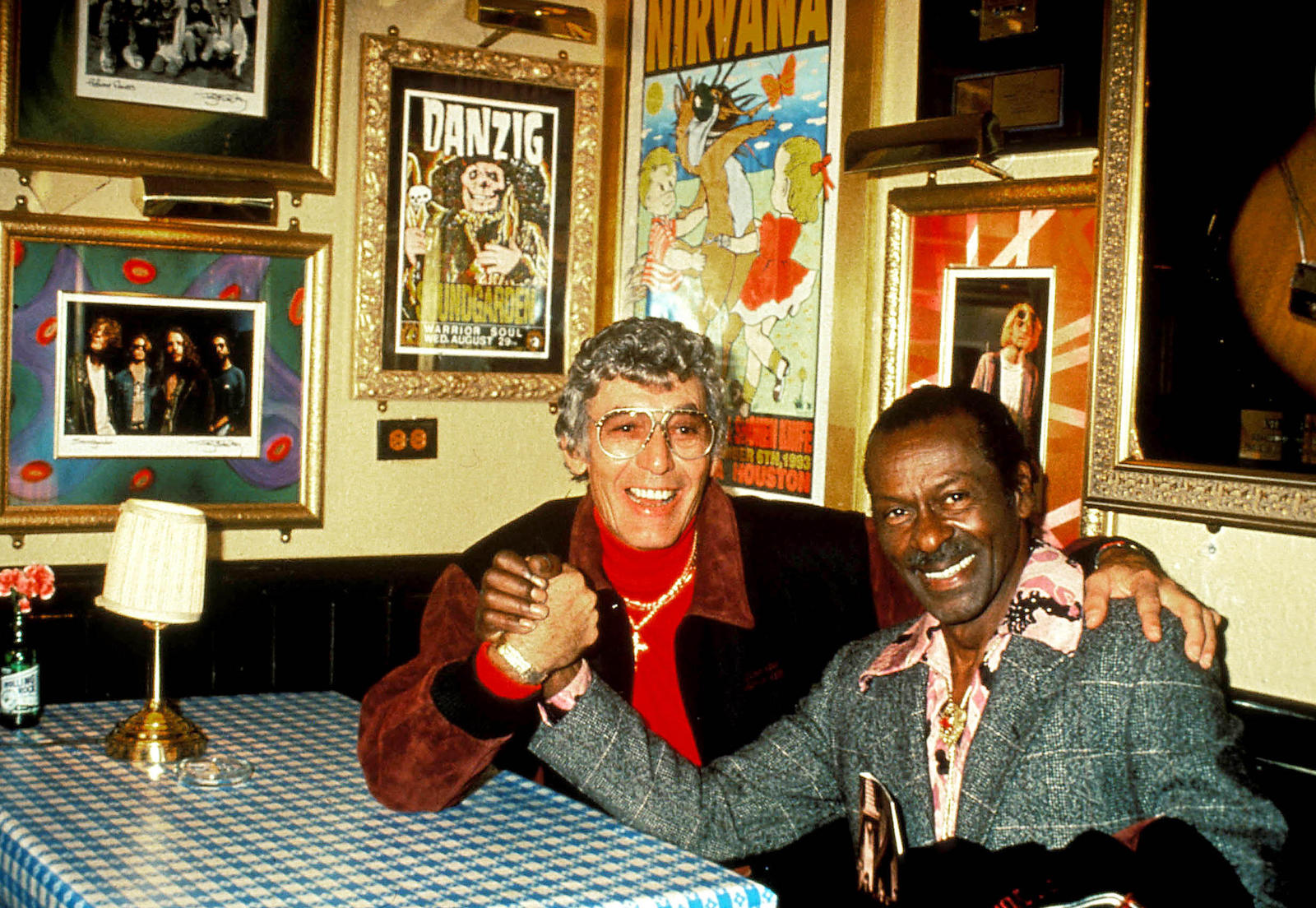This essay is excerpted from the Winter 2017 issue (vol. 23, no. 4). To read the essay in full, access via Project Muse (link at bottom).
Nothing much would have been stirring in the sleepy little hamlet of Bethel Springs as Carl Perkins passed through. The bustling McNairy County seat, five miles farther south, was another story. He would have slowed down to observe the posted speed limit signs approaching the courthouse in Selmer. Entering the square, it’s likely he shot a quick glance left to see if anything was happening at the Latta Ford Motor Company. He had been there often. The owner, Earl Latta, staged one of the best music jams for miles around right there in the spacious garage of his Ford dealership. A good picker could just show up on a Saturday night and count on playing with some of the best musicians anywhere, always in front of a large and enthusiastic crowd. The kid had learned a good lick or two from some of those old timers. South of town, the road rose slightly and flattened out, running straight on into Eastview, Tennessee, near the Mississippi state line, the young guitarist’s final destination.1
An affable fiddler by the name of Stanton Littlejohn was a regular at the Latta jams. Littlejohn was an astute and knowledgeable observer of the local music scene who had a little family band that played the occasional dance or picnic. He knew all the players on the local music circuit and everybody loved Stanton. Those connections came in handy when he picked up a secondhand recording console around 1947 and started one-offing acetate discs in the front parlor of his Eastview, Tennessee home. Almost immediately, musicians and vocalists started showing up at his doorstep, most often unannounced. For the few cents it took to buy the blank discs used in the process, artists could walk away with their very own records. Stanton never charged for his services, but rather insisted on keeping the alternate recordings as payment, or sometimes requested a second recording for his collection when he took a liking to a particular artist or song, which he often did.2

Perkins’s nerves were probably a little threadbare when he turned onto Littlejohn’s muddy gravel driveway and snaked his way down to the modest, white timber frame house. When things got underway, Charlie launched into one of his old favorites, “Devil’s Dream.” Whether it was nerves or just the rare gaffe from the virtuoso fiddler, Charlie fumbled the intro so bad the band didn’t know where to come in. He nailed it the second time. Stanton lifted the record and scrawled the date onto the label and added Devil Dream, and the band’s name, Southern Playboys. At the bottom he wrote Charley Cox / Violin. He flipped the acetate over and reseated it on the turntable.3
The confident retooling of a country classic by a novice guitarist from Jackson, Tennessee, must have impressed Littlejohn. He marked the label: Carl Perkins & Southern Playboys.
On the B-side, they recorded “There’s Been a Change in Me,” a tune that was just then making its way onto the playlists of mid-South radio. Eddy Arnold’s dulcet ode to the transformative power of romantic love would top the country charts later that year, but this version was different. It had all the elements of the hit single but with a confident electric guitar intro instead of the requisite hillbilly pedal steel. And it was rawer, much rawer, in a way that seemed to punch holes in the sentimentality of the original. The short novelty quips between each verse also followed Arnold’s lead but seemed, somehow, more salacious. Near the end of the tune, the vocalist whistled to emphasize the lyric about his growing popularity with the neighborhood girls. Where Arnold’s version suggested something like a playful, knowing wink, this one was all honky-tonk catcall. It was the kid from Jackson who had stepped to the mic and confidently delivered that memorable vocal and instrumental performance. Littlejohn held onto it for the rest of his life. The confident retooling of a country classic by a novice guitarist from Jackson, Tennessee, must have impressed Littlejohn. He marked the label: Carl Perkins & Southern Playboys.4
“Carl, There’s Been a Change in You”
It was Littlejohn’s second session with Carl Perkins that best illuminated the sustained cross-pollination between the region’s black and white musical traditions.5
From the first pickup notes into two songs from this session, “Drinkin’ Wine Spo-Dee-O-Dee” and “Good Rockin’ Tonight,” it is evident that this is something far different from anything Eddy Arnold or any of the white old-time players might have done—far different, in fact, from any other recording yet discovered from the Littlejohn archive. This is unmistakably rock ’n’ roll. Some point to “Drinkin’ Wine Spo-Dee-O-Dee” as a portent of the rock ’n’ roll revolution. Trifling speculations about what might be the first rock ’n’ roll recording aside, “Drinkin’ Wine Spo-Dee-O-Dee” is certainly numbered among the most influential tunes that seemed to presage the seismic cultural shifts of the rock ’n’ roll era. A vulgar jump blues number performed by Granville Henry “Stick” McGhee to entertain his army buddies, and later toned down for the commercial market, “Drinkin’ Wine Spo-Dee-O-Dee” is an exuberant testimonial to the New Orleans party spirit and one libation that fueled it.6
A single with a similar history, “Good Rockin’ Tonight” entered the charts twice in 1947 as an R&B sensation, recorded first by its composer Roy Brown and later by blues shouter Wynonie Harris. Harris’s single would top the charts and remain in the number one slot for six months. The lasting popularity of the tune is demonstrated by a rare second appearance on the R&B charts in 1949, this time with Brown’s original recording. Like “Drinkin’ Wine Spo-Dee-O-Dee,” “Good Rockin’ Tonight” heralded a sea change in popular music and seems to make everyone’s top ten list of prototypical rock ’n’ roll singles. Those inclined to make such lists sometimes go so far as to suggest that Brown’s composition was the first to use “rock” or “rockin’” to describe music rather than high-spirited fornication, though that is far from clear to the casual listener. “I’m gonna hold my baby as tight as I can, tonight she’ll know I’m a mighty, mighty man.” You be the judge.7

Perkins’s versions of “Drinkin’ Wine Spo-Dee-O-Dee” and “Good Rockin’ Tonight” are virile cuts that give the listener some sense of what it must have been like to hear the Perkins brothers live at the Cotton Boll, El Rancho, or the other West Tennessee honky-tonks where the band hammered out its signature sound between brawls. The tracks are manifestly drawn from the recordings of McGhee and Harris. Both bristle with the same raw sexuality and intemperance that characterize the earlier recordings and utilize nearly identical call and response motifs in the chorus. “Elderberry Wine!” Perkins shouts and the chorus answers, “Wine! Wine! Wine!” or “Hey buddy, let it rock!” he calls, and the band responds, “Rock! Rock! Rock!” Perkins even stamped his own moniker on “Drinkin’ Wine Spo-Dee-O-Dee” with the exultant shout, “better pass that bottle to Perk!” (He had used a similar device in the earlier recording of “There’s Been a Change in Me” by inserting the lyric “Carl, there’s been a change in you.”) In the last chorus of “Drinkin’ Wine Spo-Dee-O-Dee,” Perkins spurs the backup singers on with, “You’re singing mighty pretty, boys,” and the track concludes with a withering solo that leaves little doubt as to how the young man first established his reputation as a top-notch guitar picker. “Good Rockin’ Tonight,” which Perkins lyrically rebrands “everybody’s rockin’ tonight,” is rendered in an almost identical style: same key, same stop section in the verse, same call and response in the chorus, and an equally impressive guitar solo.
Perkins’s versions of “Drinkin’ Wine Spo-Dee-O-Dee” and “Good Rockin’ Tonight” are virile cuts that give the listener some sense of what it must have been like to hear the Perkins brothers live at the Cotton Boll, El Rancho, or the other West Tennessee honky-tonks where the band hammered out its signature sound between brawls.
These tracks unquestionably demonstrate that Perkins had a penchant for merging blues and country at an early age. By the time Littlejohn’s informal recording sessions were underway, the arbitrary, catchall designation “race music,” for any release by a black artist (as compared to hillbilly and country western, which had become, what else?—white music) was already deeply ingrained in the commercial recording industry. Taken together, the racial stratification of the commercial recording industry and growing racial tensions of the postwar period may account, in part, for the absence of African American voices in the Littlejohn archive. But if Littlejohn’s collection is missing black artists, it is not without their influence. Elvis Black and Waldo Davis, two of the area’s most renowned and often emulated elder statesmen of old-time music, were favorite subjects for Littlejohn. Both fiddlers incorporated elements of jug band and blues music into their repertoires with popular regional success from the early twentieth century onward. Black’s most striking recording with Littlejohn was an energetic fiddle rendition of the old Gus Cannon jug band classic “Pig Ankle Strut,” while Davis recorded at least two smoldering versions of James “Kokomo” Arnold’s “Milk Cow Blues,” a tune which also found its way into the canons of western swing, country, and rockabilly. Like other old-time musicians across the South, they unabashedly adapted and appropriated black identified music into what we now think of as white styles with alacrity, well before the rock ’n’ roll revolution fixed such a notion in the popular imagination.8

Stanton Littlejohn’s recordings of artists like Davis and Black, who came of age in the first half of the twentieth century, are clear evidence that the white old-time musicians of the region had already begun to incorporate styles and tunes that drew liberally from the repertoires of black artists into their own music. Perkins’s rural, West Tennessee ranging had put him in contact with musicians, both black and white, who covered one another’s songs and drew from a well of common experiences. Similar—though more subtle—strains had already been heard in the music of well-known white, southern artists from Jimmie Rodgers (Mississippi) to Hank Williams (Alabama), but what set Perkins apart was the unvarnished African American influence evidenced in his earliest creative choices. His recordings of two popular R&B tunes must have seemed more like a natural evolution than a revolution to everyone involved, but make no mistake: it was one thing for a white fiddler to adapt melody or structure from a traditionally black tune, and quite another to sing and perform in the style of black artists. Where the older generation’s relationships to black culture had been more “imitative,” Perkins’s sound was clearly “assimilative.” There was potential danger in the difference. Had his honky-tonk following felt like protesting, however, there was just enough twang to win over white audiences.9
If rock ’n’ roll is, as some suggest, the illegitimate offspring of hillbilly and R&B, Stanton Littlejohn’s recordings demonstrate that Perkins was well ahead of the commercial curve. These tunes are probably better known now as standards from Sun Records’s grittiest early rockabilly recordings. Sun had taken root in the fertile soil of Memphis, Tennessee, where the company’s founder and producer Sam Phillips recorded an incredible roster of regional blues artists. The immediate success of Elvis Presley—a white country performer with a blues-inflected sound—drastically altered the company’s course. “Good Rockin’ Tonight” was, of course, Elvis Presley’s second Sun single. “Wine” is probably most identified with Jerry Lee Lewis as a mainstay of his live shows dating back to his earliest days as a performer. Both tunes remain stock selections for many contemporary rockabilly and other roots music artists.10
The music was alive and well long before there was a Sun Records or a national appetite for rock ’n’ roll. Rock ’n’ roll was alive in the blues. It was alive in country. It was alive in men like Carl Perkins who didn’t care much about making such distinctions.
If the rooster on Sun’s now familiar yellow label was meant to evoke authentic rustic origins, what Littlejohn captured feels like the unadulterated item. And it was much more than that. The ease with which rural artists blended black and white styles was no revelation in itself—certainly not to southern musicians and audiences who were accustomed to such practices. But Perkins’s unapologetic, driving delivery of R&B tunes in a hillbilly style evinced a greater degree of black influence in the postwar generation than his elders might have imagined. The list of Sun artists and the astonishing sonic legacy Sam Phillips bequeathed to posterity speak for themselves, but narratives that cast him and Elvis Presley in the role of rock’s progenitors are not only reductive; they fail to recognize something vital about the musical milieu in which they did their best work. The music was alive and well long before there was a Sun Records or a national appetite for rock ’n’ roll. Rock ’n’ roll was alive in the blues. It was alive in country. It was alive in men like Carl Perkins who didn’t care much about making such distinctions.11
This essay appears in the Winter 2017 issue (vol. 23, no. 4). To read the full essay, vist Project Muse.
I am deeply indebted to Martin Fisher, Greg Reish and the staff at The Center for Popular Music—both past and present—for their encouragement and technical assistance with this project. The many fine people of West Tennessee, especially the leadership of Arts in McNairy, deserve special recognition for aiding and abetting my protracted digging in their history and cultural affairs. I am particularly grateful for the enthusiastic support and affirmation of the Stanton Littlejohn and Carl Perkins families. —Shawn Pitts
Shawn Pitts is a former president of the Tennessee Folklore Society and serves on the boards of Humanities Tennessee and the Tennessee Arts Commission. In 2012 he was awarded by the American Folklife Center, Library of Congress for documentation and preservation of the Stanton Littlejohn recordings. NOTES
- Peck Boggs, interview by Shawn Pitts, October 2012.
- Marjorie Littlejohn Richard, interview by Shawn Pitts, October 2012; Boggs, interview; Kay Bain, interview by Shawn Pitts, May 2013; Don Rayburn Richard, interview by Shawn Pitts, October 2012.
- Traditional, “Devil’s Dream,” performed by Charlie Cox, January 1, 1951. Acetate disc. The Littlejohn Sessions, Vol. 1, produced by Arts in McNairy, 2012, from recordings in the Stanton Littlejohn Archive, private collection of acetate discs held by Marjorie and Don Rayburn Richard, Jackson, Tennessee. Compact disc. Subsequent references to The Littlejohn Sessions, Vol. 1 are abbreviated as Littlejohn Sessions. Subsequent references to the Richards’ archival holdings are abbreviated as Stanton Littlejohn Archive.
- Cy Coben, “There’s Been a Change in Me,” performed by Carl Perkins, January 1, 1951. Acetate disc. Stanton Littlejohn Archive; Cy Coben, “There’s Been a Change in Me,” performed by Eddy Arnold, RCA Victor 48-0412-A, 1950. 45 rpm record.
- Tracey E. W. Laird, Louisiana Hayride: Radio & Roots Music along the Red River (Oxford: Oxford University Press, 2005), 37–39.
- Stick McGhee, “Drinkin’ Wine Spo-Dee-O-Dee,” performed by Perkins, date unknown. Acetate disc. Stanton Littlejohn Archive. Stick McGhee is also sometimes referred to as “Sticks” McGhee; Roy Brown, “Good Rockin’ Tonight,” performed by Perkins, date unknown. Acetate disc. Stanton Littlejohn Archive; Laird, Louisiana Hayride (Oxford: Oxford University Press, 2005), 37–39.
- Roy Brown, “Good Rockin’ Tonight,” performed by Roy Brown, DeLuxe 1093, 1947. 45 rpm record; Roy Brown, “Good Rockin’ Tonight,” performed by Wynonie Harris, King 4210, 1947. 45 rpm record; Bill Dahl, “Wynonie Harris.” AllMusic. Accessed January 2016. http://www.allmusic.com/artist/wynonie-harris-mn0000960674/biography; Bill Dahl, “Roy Brown.” AllMusic. Accessed January 2016. http://www.allmusic.com/artist/roy-brown-mn0000343396/biography; Dawson and Propes, What Was the First Rock ’n’ Roll Record?
- Noah Lewis, “Pig Ankle Strut,” performed by Elvis Black, April 27, 1950. Acetate disc. Littlejohn Sessions; Noah Lewis, “Pig Ankle Strut,” performed by Gus Cannon and the Jug Stompers, Victor V38006, 1928. 78 rpm record; James “Kokomo” Arnold, “Milk Cow Blues,” performed by Waldo Davis, ca. 1950. Acetate disc. Littlejohn Sessions; Kokomo Arnold, “Milk Cow Blues,” performed by Kokomo Arnold, Decca 7026, 1934. 78 rpm record; Jean A. Boyd and Patrick Kelly, “The Many Faces of ‘Milk Cow Blues’: A Case Study,” Journal of Texas Music History Volume 12 (December 2012): 16–35. Artists as diverse as Aerosmith, George Strait, Elvis Costello, Bob Wills, and Elvis Presley would later record “Milk Cow Blues.” A song of the same title was first recorded by West Tennessee country-blues great Sleepy John Estes in 1940, but it bears only slight resemblance to the tune that Arnold popularized.
- Norman Cohen, “Folk Music Discography,” Western Folklore 30, no. 3 (July 1971): 244.
- Good Rockin’ Tonight: The Legacy of Sun Records, directed by Bruce Sinofsky (Chatsworth, CA: Image Entertainment, 2001), aired 28 November, 2001, on PBS and accessed on DVD; Colin Escott and Martin Hawkins, Good Rockin’ Tonight: Sun Records and the Birth of Rock ’n’ Roll (New York: St Martin’s Press, 1991); Peter Guralnick, Sam Phillips: The Man Who Invented Rock ’n’ Roll (New York: Little, Brown and Company, 2015), 239–241. “Movie Magg” (b/w “Turn Around”) was actually released on Flip instead of Sun. Phillips initially intended to use the Flip label to test market his experimental country recordings on a regional scale; Perkins and McGee, Go, Cat, Go, 96. Perkins’s biographer, David McGee, insightfully characterized “Turn Around” as “unadulterated country soul.”
- W. S. Holland, interview by Shawn Pitts, March 2009.


